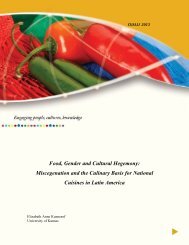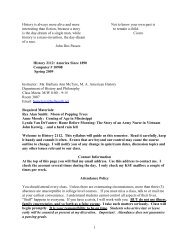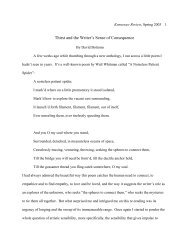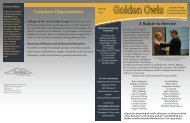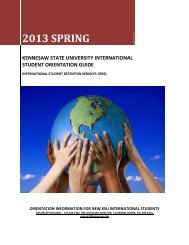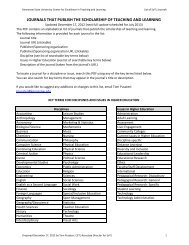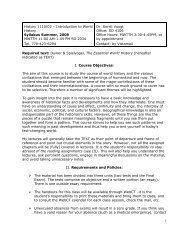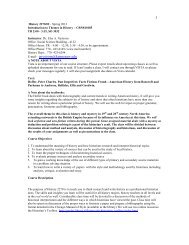Beyond Rosie: Women in World War II - Kennesaw State University
Beyond Rosie: Women in World War II - Kennesaw State University
Beyond Rosie: Women in World War II - Kennesaw State University
Create successful ePaper yourself
Turn your PDF publications into a flip-book with our unique Google optimized e-Paper software.
<strong>Beyond</strong> <strong>Rosie</strong>: <strong>Women</strong> <strong>in</strong> <strong>World</strong> <strong>War</strong> <strong>II</strong><br />
Introduction:<br />
1. Introduce the military auxiliary services of the United <strong>State</strong>s to the students, bra<strong>in</strong>storm<br />
reasons why the United <strong>State</strong>s military allowed women to only serve <strong>in</strong> auxiliary roles rather<br />
than as equals to men. Discuss reasons why women would jo<strong>in</strong> these services, and the impact<br />
that this would have had on these women.<br />
Part 1: Primary Source Analysis of <strong>Women</strong> <strong>in</strong> Military Auxiliary Services<br />
1. Distribute one of the three attached photographs (Source Sheet 9, 10, and 11) to each<br />
member of the class and ask them to analyze the photograph by discuss<strong>in</strong>g the follow<strong>in</strong>g<br />
questions:<br />
• What details are shown about this woman’s <strong>in</strong>volvement <strong>in</strong> a military auxiliary service?<br />
• What details about this woman’s activities are not shown here? Why do you th<strong>in</strong>k that is?<br />
• Does this photograph tell us anyth<strong>in</strong>g about the relationship between men and women<br />
who served dur<strong>in</strong>g the war?<br />
2. Discuss the student answers to these questions as a class, ask<strong>in</strong>g students to present their<br />
answers and lead a discussion with the class about the photograph that they analyzed.<br />
3. Compare and contrast the images as a class. What different aspects of women’s <strong>in</strong>volvement<br />
<strong>in</strong> the military auxiliary services are shown <strong>in</strong> these photographs? How do these photographs<br />
depict the complexity of women’s <strong>in</strong>volvement <strong>in</strong> these services?<br />
PAGE 18<br />
Part 2: International comparisons and contrasts<br />
1. Instruct the students to conduct research about the roles that British women played <strong>in</strong><br />
relation to the military dur<strong>in</strong>g <strong>World</strong> <strong>War</strong> <strong>II</strong>. A good start<strong>in</strong>g resource is:<br />
http://www.bbc.co.uk/history/british/brita<strong>in</strong>_wwtwo/women_at_war_01.shtml.<br />
2. Have the students write two pages of analysis that compare and contrast the experience<br />
of British and American women <strong>in</strong> relationship to the military dur<strong>in</strong>g the war.<br />
3. The students should focus their analysis on men’s attitudes towards women serv<strong>in</strong>g <strong>in</strong> the<br />
military, women’s experiences, the work that they were and were not allowed to do, and the<br />
impact that these experiences had on the women <strong>in</strong>volved.<br />
Part 3: First-hand accounts of the military auxiliary services<br />
1. Instruct the students to read part one of Noreen Jackson’s oral history about life <strong>in</strong> Brita<strong>in</strong><br />
as <strong>World</strong> <strong>War</strong> <strong>II</strong> broke out and the role that she played <strong>in</strong> Bomber Command:<br />
http://195.188.87.10/history/ww2peopleswar/stories/16/a5657916.shtml.<br />
2. Ask the students to answer the follow<strong>in</strong>g questions about Mrs. Jackson’s experience dur<strong>in</strong>g<br />
the war:<br />
• What was Noreen Jackson’s experience of the Bomber Command and Coastal Command<br />
dur<strong>in</strong>g the war?<br />
• What emotions does Jackson associate with her work dur<strong>in</strong>g the war? Why do you th<strong>in</strong>k<br />
this is?<br />
• What are the ma<strong>in</strong> events and experiences that Jackson speaks about? Why do th<strong>in</strong>k you<br />
she focuses on some aspects and not others?<br />
• What was the most surpris<strong>in</strong>g piece of <strong>in</strong>formation you learned from read<strong>in</strong>g this oral<br />
history and why?<br />
• Are there any pieces of <strong>in</strong>formation that you would want to ask a follow-up question<br />
about? What would your follow-up question be?



